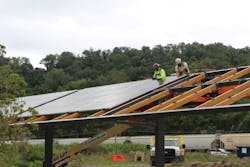Top Tips for Integrating Solar Panel Systems on Your Commercial Building
(Photo: Commercial building owners and managers should always consult a NABCEP- (North American Board of Certified Energy Practitioners) certified installer when considering solar. “These experienced installers provide detailed analysis along with turnkey designs and installations, including engineering, permitting, fabrication and construction,” says Michael Carnahan, Scalo Solar Solutions. Credit: Scalo Solar)
Commercial buildings’ rooftops are constantly being bombarded with free energy from the sun. Installing solar panels on roofs and even over parking spaces can be an efficient way of collecting that natural energy, as well as utilizing otherwise unused space. Knowing what to look for and what to avoid when it comes to installing the panels, however, can be a tricky process to navigate in the growing solar panel industry.
“Whether you believe in climate change or not, many of your tenants or employees probably do. Adding solar panels to a building not only reduces our use of fossil fuels and decreases carbon emissions, but it makes a statement to your tenants or employees that their health and wellbeing matters,” says Michael Carnahan, vice president and general manager of Scalo Solar Solutions. The Pittsburgh-based company creates solar power and energy solutions for commercial properties and local residences.
Solar Installation 101
Carnahan explains that solar solutions are a combination of roofing work and electrical work. “You don’t want to put anything on your roof that would endanger your water-tightness or roofing warranty, so it is important to find an installer who has experience in both,” he notes. “After a careful site analysis that looks at electrical, roofing and structural concerns, solar can be designed specifically with your building in mind.”
When installing solar on spray foam roofing, Dave Feitl, Huntsman Building Solutions, points out that owners will want to avoid installing the panels directly onto the spray foam roof surface to prevent solar heat and water accumulation between the panels and rooftop coating. Credit: Huntsman Building Solutions
For traditional solar panel installation, Carnahan says the “racking” or structural supports that hold the panels are anodized aluminum or stainless steel to maintain a solid physical connection and good product longevity. These systems can then be ballasted, penetrated or a combination of both depending on a number of factors.
Carnahan states that a certified solar professional will maintain pathways and accessibility to rooftop equipment and consider long-term safety for maintenance personnel. He also recommends following these tips when it comes to the installation process:
-
Always consult a NABCEP- (North American Board of Certified Energy Practitioners) certified installer when considering solar. These experienced installers provide detailed analysis along with turnkey designs and installations, including engineering, permitting, fabrication and construction.
-
Because solar panels have a 25-year warranty, building managers or owners should consider the age of your roof before installing solar. Replacing a roof is the absolute best time to consider going solar, as the roof and solar would both warranty out at approximately the same time.
-
And, be wary of anyone willing to install solar on an old or aging roof that will need to be replaced in the next few years.
He notes that solar solutions are no longer for just rooftops; solar can be built into the building’s design with solar canopies, covered walkways, window shades, and even solar parking lots that provide shade and electric vehicle charging to employees or patrons.
Solar Systems Plus Spray Foam Roofing
Some companies, like Huntsman Building Solutions, also focus on combining solar systems with spray foam roofing.
Carnahan recommends installing your solar panels at the same time as replacing your roof. This way, the 25- to 35-year lifespan of your roof and solar panels are aligned and can ensure the stability of the system if there is a new roof supporting it. Credit: Scalo Solar
“Spray foam roofing and solar systems are an ideal combination on the roof of commercial facilities as the pair provides both energy efficiency and renewable energy generation,” says Dave Feitl, vice president of global roofing and western USA spray foam sales for Huntsman Building Solutions. He states that the joint solution takes advantage of spray foam roofing’s ability to superbly seal the roof, provide exceptional thermal insulation, waterproofing, weather resistance and long-term durability, along with the obvious benefits of solar power.
“Facility owners who want to optimize their buildings, reduce or eliminate their energy costs altogether, along with insulate for increased indoor comfort, are rapidly pairing the two systems on roofs,” Feitl notes. “Spray foam roofing and photovoltaics are the perfect partnership to achieve net zero energy in various types of commercial structures across the country.”
[Related: Solar Panels Could Ruin Your Roof]
He adds that the return on investment of spray foam roofing and solar can be quite meaningful as the systems can eliminate long-term energy bills, which in commercial facilities can be substantial. Additionally, there are tax incentives which may be used to offset the initial investment including the Solar Investment Tax Credit, a 22% credit in 2021 that benefits businesses that install, develop or finance the commercial facility in question.
“Additionally, recent changes to Section 179 of the tax laws provide building owners with tax deductions for roof retrofits and replacements,” Feitl says. “The tax changes now allow short-term capital expenditures for these retrofits and replacements to be considered for a full tax write-off for the same year the investments were made.”
Do’s and Don’ts for Solar and Spray Foam Roofing
There are some technical considerations when joining solar systems with spray foam roofing. Feitl says best practices call for solar to be installed through rack installation over spray foam roofing and that crystalline silicon is the primary type of solar panel utilized.
Credit: Scalo Solar
“It is imperative that the spray foam is protected with silicone- or acrylic-based coatings, which are typically utilized for waterproofing, UV protection and to extend the lifespan of the roof,” he notes. “Because the roof surfaces underneath the solar panels may not dry as fast as the uncovered portions, it is important that the coating selected is able to withstand pooled water and biological growth.”
Furthermore, Feitl says a spray foam roof will be stressed during the installation of photovoltaics, as well as during regular maintenance. “The addition of the solar system on a spray foam roof will lead to additional foot traffic over time. Trafficked areas may be protected with additional coating and granules or walk pads.”
When installing solar on spray foam roofing, Feitl points out that owners will want to avoid installing the panels directly onto the spray foam roof surface to prevent solar heat and water accumulation between the panels and rooftop coating. Additionally, the solar system must not block access to drains, penetrations, flashings, mechanical units or other equipment on the roof.
Building construction and design professionals can always reference the Spray Polyurethane Foam Alliance (SPFA) for more information and resources on choosing the right installation system. Visit sprayfoam.org for more information.
Read next: Where to Start When Your Building is Ready for Solar Energy
About the Author

Adrian Schley
Staff Writer
Adrian Schley has been writing for interiors+sources magazine since March of 2018 and creates content for the BUILDINGS team. She earned her BA in journalism at the University of Iowa, where she also studied English.
